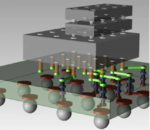I knew that HDMI was a popular standard used to connect consumer products like a monitor to a laptop, but most professional video and broadcast systems use the SDI (Serial Digital Interface) connector standard. Pleora Technologies, founded in 2000, currently serves the machine vision and manufacturing markets, including those… Read More
Analysis and Verification of Single Event Upset Mitigation
The evolution of space-based applications continues to drive innovation across government and private entities. The new demands for advanced capabilities and feature sets have a direct impact on the underlying hardware, driving companies to migrate to smaller geometries to deliver the required performance, area, and power… Read More
SystemVerilog Has Some Changes Coming Up
SystemVerilog came to life in 2005 as a superset of Verilog-2005. The last IEEE technical committee revision of the SystemVerilog LRM was completed in 2016 and published as IEEE 1800-2017.
Have the last seven years revealed any changes or enhancements that maintain SystemVerilog’s relevance and efficaciousness in the face … Read More
A Complete Guidebook for PCB Design Automation
Printed Circuit Boards (PCBs) are the foundation of modern electronics, and designing them efficiently is complex. Design automation and advanced PCB routing have transformed the process, making it faster and more reliable. Design automation streamlines tasks, reduces errors, and ensures consistency. Advanced PCB routing… Read More
Siemens Digital Industries Software Collaborates with AWS and Arm To Deliver an Automotive Digital Twin
According to McKinsey & Company, a digital twin is a digital representation of a physical object, person, or process, contextualized in a digital version of its environment. Digital twins can help an organization simulate real situations and their outcomes, ultimately allowing it to make better decisions. Anyone… Read More
Handling metastability during Clock Domain Crossing (CDC)
SoC designs frequently have lots of different clock domains to help manage power more efficiently, however one side effect is that when the clock domains meet, i.e., in a Clock Domain Crossing (CDC), there’s the possibility of setup and hold time violations that can cause a flip-flop to become metastable. Synchronizer … Read More
Uniquely Understanding Challenges of Chip Design and Verification
Jean-Marie Brunet is Vice President and General Manager of Siemens Hardware-Assisted Verification. He and I spoke recently about how different his hardware group is from the rest of the software-centric EDA product space and why a hardware-oriented EDA vendor like Siemens fully understands the challenges of the chip design… Read More
Successful 3DIC design requires an integrated approach
While the leap from traditional SoC/IC designs to Three-Dimensional Integrated Circuits (3DICs) designs brings new benefits and opportunities, it also introduces new challenges. The benefits include performance, power efficiency, footprint reduction and cost savings. The challenges span design, verification, thermal… Read More
Make Your RISC-V Product a Fruitful Endeavor
Consider RISC-V ISA as a new ‘unforbidden fruit’. Unlike other fruits (ISAs) that grow in proprietary orchards, RISC-V is available to all, i.e. open-source. Much like a delicious fruit can be transformed into a wide array of delectable desserts, so can RISC-V be utilized to create a plethora of effective applications across … Read More
Ensuring 3D IC Semiconductor Reliability: Challenges and Solutions for Successful Integration
One of the most promising advancements in the semiconductor field is the development of 3D Integrated Circuits (3D ICs). 3D ICs enable companies to partition semiconductor designs and seamlessly integrate silicon Intellectual Property (IP) at the most suitable process nodes and processes. This strategic partitioning yields… Read More









